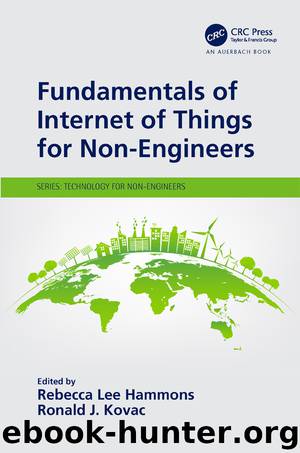Fundamentals of Internet of Things for Non-Engineers by Rebecca Lee Hammons

Author:Rebecca Lee Hammons
Language: eng
Format: epub
Publisher: CRC Press
Published: 2019-03-15T00:00:00+00:00
10.5 Case Study: AI and OpenAI
AI is capable of many great things, more now than ever before. One of AI’s greatest potentials lies in the ability to learn and solve complex problems. A perfect example of the capabilities of AI learning can be found in the efforts of the team at OpenAI. They are a nonprofit AI research company that is focused on creating AGI or artificial general intelligence.19 Through the company’s efforts they have managed to apply their AI learning techniques to the world of professional gaming.
They wanted to create an AI that could stand its own against some of the best players of Dota 2, one of the most complicated strategy games. Dota 2 is a multiplayer online battle arena (MOBA) that pits two teams of five players each against each other to see who can destroy the others ancient, a structure located on either side of the map, first. The game boasts a character roster of over 100 heroes to play all with their own set of abilities and statistics. These heroes can hold up to six different items from a pool of over 100 as well. This all builds up to an exhaustingly complex game with a constantly changing dynamic as the games progress according to the players’ abilities. Looking at the setup, it would seem almost impossible for an AI to understand the complexities of this game and be able to best a human player, let alone some of the best players the community has to offer. It may seem impossible, but it is not.
The team over at OpenAI started small at first. Instead of creating a whole team of AIs to fight in a regular game of Dota 2, they created one that could hold its own in a 1v1 situation. They employed the tactic of self-play to get the AI to learn how to play the game. They would simulate a fresh game of Dota 2 and pit the AI against itself (i.e., have the AI tool play against itself). They gave it basic rules to not die and try to win the game. They would simulate hundreds of games at a time, equating to about 300 years of experience a day, to let the AI explore its environment and learn how to survive and thrive. As time passed, the team built a reward system that helped refine the AI’s decision-making process.
The reward system is easily comparable to the same reward system we have in our own brains. When we do something good, we are rewarded with a chemical feeling in our brain as feedback. The AI works in a similar fashion except with a simple point system instead of brain chemicals. The AI’s goal is to increase its points at every moment it can. It would actively weigh the outcomes of its decisions and predict its next moves to maximize its total points by the end of the game.20 This reward system laid the foundation for the AI’s growth.
At first, it would just
Download
This site does not store any files on its server. We only index and link to content provided by other sites. Please contact the content providers to delete copyright contents if any and email us, we'll remove relevant links or contents immediately.
| Antennas | Microwaves |
| Mobile & Wireless | Networks |
| Radar | Radio |
| Remote Sensing & GIS | Satellite |
| Signal Processing | Telephone Systems |
| Television & Video |
Whiskies Galore by Ian Buxton(41704)
Introduction to Aircraft Design (Cambridge Aerospace Series) by John P. Fielding(33008)
Small Unmanned Fixed-wing Aircraft Design by Andrew J. Keane Andras Sobester James P. Scanlan & András Sóbester & James P. Scanlan(32676)
Craft Beer for the Homebrewer by Michael Agnew(18068)
Turbulence by E. J. Noyes(7884)
The Complete Stick Figure Physics Tutorials by Allen Sarah(7253)
Kaplan MCAT General Chemistry Review by Kaplan(6806)
The Thirst by Nesbo Jo(6744)
Bad Blood by John Carreyrou(6464)
Modelling of Convective Heat and Mass Transfer in Rotating Flows by Igor V. Shevchuk(6345)
Learning SQL by Alan Beaulieu(6148)
Weapons of Math Destruction by Cathy O'Neil(6069)
Man-made Catastrophes and Risk Information Concealment by Dmitry Chernov & Didier Sornette(5862)
Digital Minimalism by Cal Newport;(5570)
Life 3.0: Being Human in the Age of Artificial Intelligence by Tegmark Max(5391)
iGen by Jean M. Twenge(5290)
Secrets of Antigravity Propulsion: Tesla, UFOs, and Classified Aerospace Technology by Ph.D. Paul A. Laviolette(5229)
Design of Trajectory Optimization Approach for Space Maneuver Vehicle Skip Entry Problems by Runqi Chai & Al Savvaris & Antonios Tsourdos & Senchun Chai(4946)
Electronic Devices & Circuits by Jacob Millman & Christos C. Halkias(4857)
